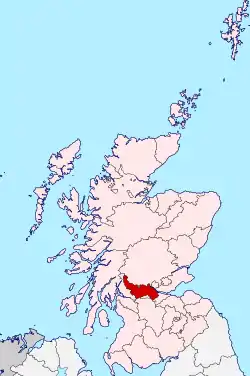Barony of Cowie, Stirlingshire
The Barony of Cowie, Stirlingshire is a Scottish feudal barony that was created in 1563, when Adam Erskine, the perpetual Commendator of Cambuskenneth, the head of the Abbey, signed a charter of some of its lands to John, 6th Lord Erskine.[1] Erskine was granted the lands of Cowy, Murtoun and Baddnidayth in the barony of Cowy in the Sheriffdom of Stirling.[2] Erskine later became the Earl of Mar.[3] The original Barony lands were between Cowie and Stirling, starting just north of the town of Bannockburn.

History
The name Cowie probably comes from the Gaelic word Collaidh, meaning wooded place.[4] Cowie has been occupied since at least Neolithic times.[5] In the Middle Ages, Cowie was held directly by the King. In the early 12th century, King David I gave lands of Cowie to Cambuskenneth Abbey.[2] In 1207, the lands of Cowie were again confirmed upon Cambuskenneth Abbey.[6] During the middle of the 16th century, the Protestant Reformation transformed the Scottish social and political landscape. When the nation formally adopted Protestantism in 1560, one of these reforms was the abolition of monasteries, abbeys and other church lands. Cambuskenneth was closed and many of the buildings were looted and destroyed, including the removal of stones for construction work in Stirling Castle.[7]
The Barony remained primarily in the Erskine family from 1563 until the first Jacobite rebellion. In 1715, John, 6th Earl of Mar (9th Baron of Cowie), became a leader of the Jacobite rebellion of James Edward, the Old Pretender.[3] Mar had no military experience and was a poor general. In an indecisive battle at Sheriffmuir in 1715, Mar was unable to defeat a smaller force under the Duke of Argyll. With the failure of the ’15, Mar fled with the Pretender to France, where he spent the rest of his life in exile.[8] In 1716, a Writ of Attainder was passed against the Earl, which stripped him and his heirs of all their lands and titles. The Murrays of Polmaise were one of the beneficiaries of the Attainder against the Earl. In 1716, Sir William Murray of Touchadam and Polmaise became the first Murray holder of Cowie. He died childless and was succeeded by his uncle William Murray, 8th of Touchadam & of Pitlochrie and Polmaise in 1729. He succeeded by his son William Murray of Touchadam, Pitlochie and Polmaise in 1758.[9] The Barony remained in the Murray family until 1926.[10]
The current (20th) Baron of Cowie is Alan Robert Dennis, the 14th great grandson of King James IV and Janet Kennedy, the daughter of the 2nd Lord Kennedy.[11] He is a professor of information systems in the Kelley School of Business at Indiana University.[12]
See also
References
- Hallen, Rev. Cornelius (1890). "The Scottish Antiquary or Northern Notes and Queries; No. 19". www.jstor.org. 5.
- "Document 1/5/100 (RRS, i, no. 241)". People of Medieval Scotland.
- Round, John Horace (1911). . In Chisholm, Hugh (ed.). Encyclopædia Britannica. 17 (11th ed.). Cambridge University Press. p. 665.
- "Gaelic Map of Scotland and Gaelic Place Names". ScotClans | Scottish Clans. 20 May 2016.
- "Cowie | Canmore". canmore.org.uk.
- GD124/1/976. National Archives of Scotland. 1562.
- "Cambuskenneth Abbey". Stirling Local History Society.
- Bruce, Maurice (December 1937). "The Duke of Mar in Exile, 1716—32". Transactions of the Royal Historical Society. 20: 61–82. doi:10.2307/3678593.
- Douglas, Sir Robert (1798). The Baronage of Scotland. Edinburgh: Bell & Bradfute. p. 112.
- CS272/5/339. National Records of Scotland. 1926.
- "The Current Baron – Barony of Cowie". baronyofcowie.uk.
- "Alan Dennis: Kelley School of Business: Indiana University". kelley.iu.edu.
